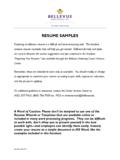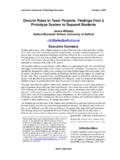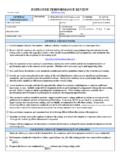Transcription of Definition Why is it important? Level 2 (+ Level 1) Level ...
1 1. Customer Focus Level 4. Definition Seeking to determine the needs of customers and taking action to satisfy them Why is it important? All employees must demonstrate a full understanding of customer needs and expectations to enable the effective delivery and development of appropriate quality services which meet customer expectations Level 1 Level 2 (+ Level 1) Level 3 (+ Levels 1 & 2) Level 4 (+ Levels 1, 2 & 3). Delivers a Service Seeks Customer Feedback to Add Understands Customer Requirements Champions Customer Focus Culture Value Identifies and clarifies individual Consistently makes decisions Acts as role model in personal Makes sure the organisation works customer needs focused on customer needs approach to customer focus to resolve issues most important to Takes ownership for solving Analyses delivery of services and Takes time to establish underlying customers customers problems provides solutions to problems needs of customers beyond those Identifies good practice and solutions Resolves customer enquiries Finds different ways to satisfy initially expressed and integrates into service provided promptly at point of contact and only customer needs
2 Organises processes around Translates operational feedback into refers to others when genuinely Takes pride in delivering high quality customer taking account of complex strategic improvements appropriate services and seeks to expand own and sensitive issues to meet their Forms strategic and diverse Interacts well with all customers skills long term needs groups/partnerships to improve taking into account customers Constantly questions how will this Implements systems to record services diverse needs benefit the customer? customer feedback and Understands all services and Seeks customer feedback to communicate ideas and information accurately matches these to investigate ways to improve Creates an environment where customers needs customer experience team/s are empowered to put Keeps customers up to date and Goes beyond their day-to-day work customers first informed to assist customers in a positive Deals with customers fairly and manner equitably Positive Indicators.
3 Treats all customers with respect Responds to all customer enquiries promptly, positively and courteously Asks lots of questions to identify customers needs Tries to see things from the customers point of view Brings ideas of ways to improve policies, procedures and service delivery to meet customers needs Actively requests feedback from customers and acts constructively upon both positive and negative feedback Goes the extra mile for customers Uses measures effectively to assess needs and demand Warning Signs: Does not treat all customers with respect Makes assumptions rather than finding out the customers needs Is not flexible about own way of doing things Is sensitive to customer concerns and carries out tasks without thought of the impact on the customer Uses jargon, bureaucracy and red tape Makes promises to customers that cannot be delivered Does not prioritise customer needs Ignores customer feedback Takes negative feedback personally Fails to assess customer needs and demand using measures 2.
4 Innovations and Change Level 4. Definition Seeking ways to bring about improvements in the way that work is done. Accepting new ways of doing things Why is it important? It is necessary to adapt and respond to different and changing demands in work now and in the future. Flexibility in interpreting rules, procedures and policy is required to deliver focused services tailored to local needs. The ability of individuals to adapt to changing circumstances is crucial in delivering a high performing service Level 1 Level 2 (+ Level 1) Level 3 (+ Levels 1 & 2) Level 4 (+ Levels 1, 2 & 3). Responds positively to change Contributes ideas to the change process Develops and implements change Drives the change agenda Is open to new ideas and listens Understands link between own Translates strategic vision into Articulates a vision that to other people's points of view work and the organisation's practical and achievable plans generates excitement, Adjusts to peaks and troughs of Strategic Objectives.
5 Is comfortable with ambiguity enthusiasm and commitment workloads Contributes positively to the Inspires others by championing Experiments and reinvents Always gives their best has a change process changes to achieve common thinking using intuition as well as positive outlook Responds effectively to changing goals complex analysis to create a new Covers for colleagues when circumstances Proactive in identifying barriers to concept or approach not obvious needed Remains focused when faced change and seeking ways to to others Responds positively to with competing demands overcome them Encourages others to create opportunities to be involved in Recognises the impact of change Fosters a learning culture, strategies, visions and innovative systems thinking interventions on others and supports them committed to continuous services Is always prepared to be flexible through it improvement and development Sees change as an opportunity Overcomes resistance to change to improve performance Thrives on leading people Uses an awareness of the bigger through change picture along with common Constantly reviews own and sense to interpret and implement section objectives to ensure they policy support the organisation's long- Identifies a pragmatic approach term Strategic Objectives, and in order to get the job done makes changes or challenges if quickly and effectively they do not Makes complex ideas, issues and situations clear and understandable Positive Indicators.
6 Forecasts the long term implications of change Supports organisational objectives even when disadvantageous in own areas Shows commitment to the long-term goals of the organisation Explains the strategic benefits of decisions to team members or colleagues Works towards planned career goals and personal ambitions Warning Signs: Pursues his or her own personal interests even when not in line with organisational objectives and values Reacts to requests or priorities without thinking about the longer term or bigger picture or without relevant data Shows no interest in learning about the organisation's work outside his or her own area Openly discusses issues in a negative way Undermines new ways of doing things Creates barriers and does not accept change 3. Analysis and Decision-making Level 4.
7 Definition Analysis and decision making is demonstrating the ability to think and reason clearly using good information to make good decisions Why is it important? This behaviour is important to deliver products and services that are creative, innovative and culturally appropriate. Internally it is making changes that increase the efficiency of our work. Externally, it is about raising the profile and improving the efficiency of our organisation Level 1 Level 2 (+ Level 1) Level 3 (+ Levels 1 & 2) Level 4 (+ Levels 1, 2 & 3). Improves and acts now Adapts existing approach, and acts Anticipates the future, and develops Creates opportunities and acts for the and looks ahead new products and services long term Looks for and suggests ways to Uses own knowledge and expertise Plans ahead and is able to spot Challenges the status quo' in order improve current work practices and to lead interventions and develop opportunities in the future to develop to identify new and better ways of provides information to support ideas new systems for self and team new approaches, products and improving strategic performance Sees things through to a high Considers key objectives and services to meet organisational Works on new initiatives that standard.
8 Despite obstacles and identifies opportunities to improve needs contribute to the development of the setbacks performance Is service oriented without sacrificing organisation Anticipates what is needed, thinks Ability to look ahead and take commerciality of business Sees and acts on long-term ahead, makes an assessment of appropriate action to improve opportunities through formulating what must be done performance, without relying on new ideas, developing key networks direction from others and using innovative approaches to Spends time in the flow of the work allow them to be realised gathering information to support the measures Positive Indicators: Sets aside thinking time to come up with more creative ways of doing things Asks colleagues to identify key factors that hinder performance and use these to plan improvements Takes advantage of new technology Looks to other areas for good ideas Is willing to be different Bases decisions on good data Warning Signs: Sticks rigidly to procedures even when inappropriate Is not open to new ideas or ways of doing things Is internally focused Sees problems but makes no effort to solve them Unable to step back from current issues to identify potential opportunities 4.
9 teamwork and Leadership Level 4. Definition Working effectively with others, as a team leader or team member, encouraging team working and supporting others Why is it important? We need more than just organisational leaders to be the figure head of a company, but also individuals across the organisation demonstrating positive leadership and team working qualities motivating and supporting others to achieve organisational, team and personal objectives Level 1 Level 2 (+ Level 1) Level 3 (+ Levels 1 & 2) Level 4 (+ Levels 1, 2 & 3). Acts as positive & responsive team member Contributes and leads in the team Develops team members Provides environment & opportunities for team working & development Treats colleagues fairly and Understands in depth what Gives timely and specific feedback Creates new opportunities for consistently motivates and encourages other on what has been done well and individuals to work together.
10 Generates a team spirit team members where there is room for improvement breaking down barriers that get in Co-operates with others Sets clear direction Encourages and seeks out feedback the way of effective team working Responds positively to requests Trusts colleagues to deliver and makes positive improvements Challenges others to do the same for help work once delegated regardless of how the feedback was Develops dynamic ways to introduce Is courteous, tactful and appropriately given new strategies to improve diplomatic Secures necessary resources Is aware of own leadership style and partnership working Leads by example and support adapts to get the best out of others Regularly maintains networks and Provides supportive Recognises potential in others and contacts to create new opportunities environment and removes encourages self development Uses appropriate opportunities to barriers to effective working Delegates to develop skill of others gain co-operation of others to build Encourages worklife balance Works to develop one team culture group lobbying and group promotion and promotes long term across the organisation of the organisations goals effectiveness Promotes partnerships as a means of







